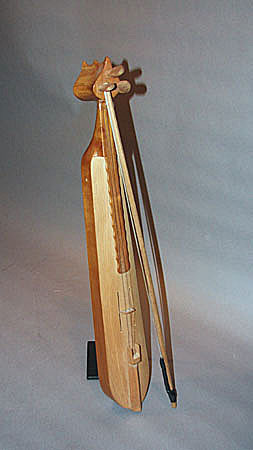
Owner: HWMC
Catalog#: ME-CHLT-09
Lutes
Turkey ‘Pontic Lyra’ (Kemenche)
Northeastern Turkey, Northern Greece
Turkish
Woods, metal string, synthetic string.
Mid 20th century
Length: 22.4 in; Width: 3.5 in; Depth: 2.1 in
Chordophones – Lutes
The Pontic lyra (Greece: kemenche) is a bowed three-stringed lute played primarily by those living in the historic Pontus region of north eastern Turkey and those who reside in the northern parts of Greece.
The Pontic lyra consists of a narrow box shaped body which includes a neck and a pegbox with a soundboard made from spruce or pine that covers the body. The three pegs made of hardwood are inserted from the front into the pegbox. Originally the strings were made from the sheep’s gut, but today wire cords are used. The bow is wooden with synthetic strings attached to both ends. While playing, the tension of the bow hair is controlled by the second and third finger while it is held with palm upwards. The strings are tuned in fourths and are played with the flesh of the fingers, and not the nails. No vibrato is use, but a drone effect with parallel fourths dominates the sound. The Pontic lyra is played while standing up or sitting down and held vertically. If sitting the bottom resting between the thighs.
The origin of the Pontic lyra was possibly between the 11th and 12 centuries, when Pontus was part of the Byzantine Empire, while the name ‘kemenche’ first appeared in the 10th century. According to Pavlos Hairopoulos, it was created by the Greeks of Pontius themselves.
Reference: During Jean, At ‘Ayan Robert, Spector Johanna, Qassim Hassan Scheherazade, Morris R. Conway, «Kamancheh», Grove Music Online – Oxford Music Online; The Pontic Lyra (Kemenche) (pontosworld.com)
